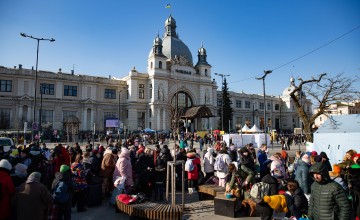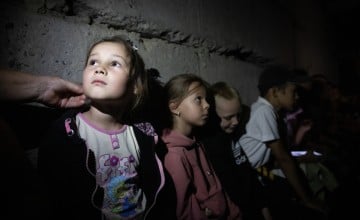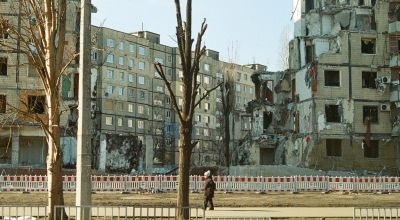
Read our 2023 annual report

Knowledge Hub
Even if peace happens overnight, the humanitarian situation in Ukraine will continue to be significant. Here’s what you need to know.
On February 24, the conflict in Ukraine will enter its fourth year since the start of the full-scale invasion in February 2022. The last three years escalated a long-simmering crisis with devastating impact, leaving 36% of the the second-largest country in Europe in need of humanitarian assistance in 2025.
As recently as this week, developments have hinted at a possible peace agreement. However, even if that were to happen overnight, the humanitarian dimensions of the situation will continue long after the fighting has ceased. Here’s what you need to know about the crisis in Ukraine in 2025.
1. Nearly 13 million Ukrainians require humanitarian assistance
Since February 2022, Ukraine rapidly became one of the world’s largest humanitarian crises, in part due to the size and population of the country. In 2025, the United Nations Office for the Coordination of Humanitarian Affairs (OCHA) estimates that 12.7 million people will require humanitarian assistance, particularly in the eastern oblasts of Kharkiv and Dnipro, where many families have been displaced from the frontlines (which expanded by 15% in 2024). Some of the most vulnerable people, including children, elderly, and people with disabilities, are still in areas with active hostilities.
The majority of humanitarian need centres on key areas where infrastructure has been damaged by fighting, including healthcare (9.8 million), protection (9.5 million, including 3.5 million children), and water, sanitation, and hygiene (WASH) services (8.5 million). While the eastern oblasts are among the hardest hit, these issues affect the entire country, especially in terms of housing and energy. Attacks on energy infrastructure have left between 65% and 80% of the national power grid damaged or unavailable, an especially critical challenge in winter with temperatures routinely below freezing.

2. The scale of humanitarian need is being lost in the headlines, with civilians paying the ultimate price
Despite the ongoing need, funding for humanitarian responses in Ukraine has begun to suffer the effects of crisis fatigue. While OCHA estimates 12.7 million people will require assistance this year, the UN’s humanitarian response plan for 2025 has only been able to target less than half of that population — some 6 million people. “This reduction is not proportional to the decrease in the number of people to be assisted, as inflation and rising operational costs have led to an increase in the cost-per-person in some areas of work,” OCHA writes in its 2025 response plan.
Inflation is a key issue here: In 2025, the cost to support collective sites, which in turn support displaced families in Ukraine, has risen by 139%. Organisations at international, national, and local levels are having to do more with less as a result, and even though the UN has budgeted a response to meet 6 million people (which will require a little over $2.6 billion in funding), it may not receive all of the funds required. As of February 2025, the response in Ukraine is less than 13% funded.

3. Ukraine is also the second-largest refugee crisis in the world
In addition to nearly 4 million internally-displaced Ukrainians as of this writing (per the UN High Commissioner for Refugees), Ukraine also has an international refugee population that ranks as the world’s second largest at the beginning of 2025.
Over 6.8 million refugees have been recorded by the UNHCR, many of whom have spent the last three years displaced in a foreign country. Many are now facing a difficult decision between permanently resettling and restarting their lives, or continuing to live in limbo in the hopes that they may return home.

4. These major needs are tied to a psychological crisis as well
The humanitarian needs and displacement driven by the crisis in Ukraine are all in a larger context of societal and psychological upheaval for families. Approximately 25% of Ukrainian children are not attending in-person learning this academic year, in part due to damaged facilities but also due to the fear that parents have of letting them out of their sight. In many frontline regions, children have not attended school in-person since before the COVID-19 outbreak. In-person classes often take place in bomb shelters that double as classrooms.
The trauma extends across generations. Elderly Ukrainians, for example, have lived through several crises since the end of World War II, and are struggling to cope with the collective impact of history. In communities, cohesion has been tested as people who either arrive from frontline areas or who return home from displacement struggle to integrate or reintegrate into communities scarred by hostilities. Roughly 63% of Ukrainian families have reported at least one form of mental health challenge due to the conflict, including an estimated 1.5 million children at risk for post-traumatic stress disorder and depression.

5. None of this will go away overnight if peace is achieved this winter
The end to this conflict will be a long road, whether that starts with peace talks this week or later on, and humanitarian assistance will be critical in these situations as well. As of this writing, attacks continue across the country, killing civilians while also destroying power grids, water supply networks, transportation infrastructure, hospitals, schools, and homes.
Nearly 4,000 educational institutions have suffered damage. The World Health Organisation estimates over 2,100 attacks on healthcare facilities. As of the beginning of 2024 (the most recent data available), over 2 million housing units were damaged. UN OCHA estimates that the direct cost of destruction could be up to $152 billion USD, with roughly a third of that cost going to the housing market.
On top of the physical damage, the economic and psychological recoveries will be long roads. Inflation in Ukraine has continued to be driven by conflict, leaving many families going further into debt to afford basic essentials while also losing incomes. This is especially true in rural areas, where one-third of Ukrainians live. Despite efforts to stabilise the economy, the need for targeted livelihoods support and cash-based assistance remains critical to ensure that households can meet their basic needs.

The crisis in Ukraine: Concern's response
Concern has been responding to the crisis in Ukraine since the early days, working collectively with our Alliance2015 partners to deliver assistance via the Joint Emergency Response in Ukraine (JERU). Through the strategic pooling of resources and combined reach, JERU has been supporting people across Ukraine through cash transfers, food and hygiene kits, and winterisation assistance delivered to frontline communities.
We’ve also expanded our focus to work with communities on long-term recovery as well as emergency response. This includes supporting small businesses and entrepreneurs impacted by the conflict to financially recover from and adapt to the changing context. This will help foster economic recovery and enhance income-generating prospects across broader communities.




